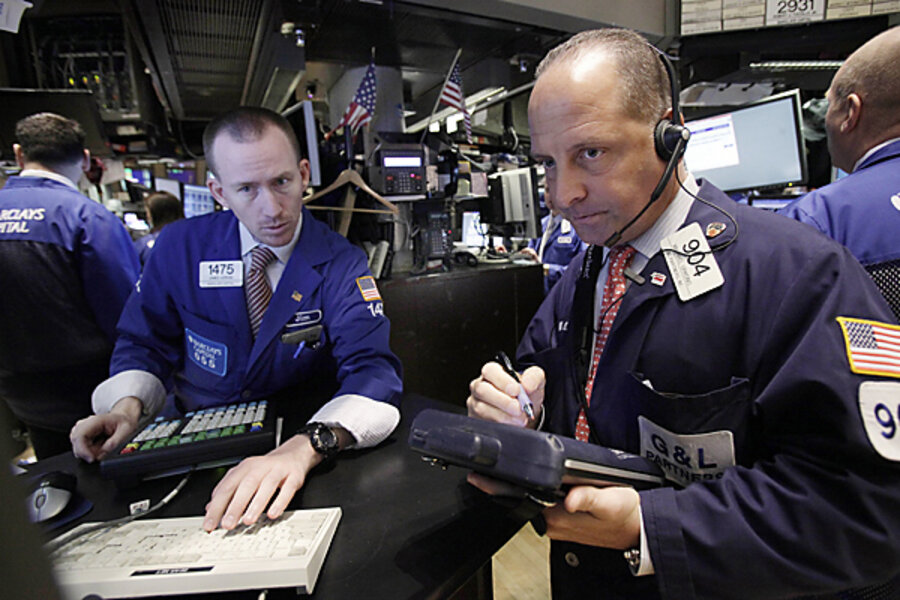Stocks close mixed as Nasdaq ekes out gain
Loading...
By Abby Schultz and JeeYeon Park, CNBC.com
Stocks ended mixed and off the lows of the session, amid concerns over the U.S. economic recovery and a weak earnings forecast from Hewlett-Packard.
The Dow Jones Industrial Average fell 68.79 points, or 0.55 percent, to close at 12,479.58, after dropping more than 170 points early in the session. It was the third straight day of losses for the blue-chip average, and the lowest close since April 20.
Hewlett-Packard led the Dow lower after news the tech giant said it would cut its forecast for the third quarter and the year—despite good first quarter results—citing the effects of the Japanese disasters, weak personal computer sales and reducing operating profit for services. In addition, at least four brokerages downgraded their ratings on the company.
HP's results were released a day before scheduled after news of a leaked memo by CEO Leo Apotheker, which warned executives of "another tough quarter."
Meanwhile, Home Depot was among Dow gainers after the home-improvement retailer beat profit estimates by one penny as investors shrugged off a drop in sales compared with last year. Home Depot blamed bad weather for the sales slump.
The S&P 500 fell 0.49 points, or 0.04 percent, to close at 1,328.98, the lowest close since April 19 and the third straight down day. The tech-heavy Nasdaq rose 0.90 points, or 0.03 percent, to close at 2,783.21, edging into positive territory just before the market closed. Stocks have already had as many down days in May as in April. The CBOE Volatility Index, widely considered the best gauge of fear in the market, rose above 18.
Among key S&P 500 sectors, industrials and materials fell, while defensive sectors such as utilities gained.
Although it feels a lot worse, the S&P 500 is only down 3.5 percent from its peak in late April, said Oliver Pursche, president of Gary Goldberg Financial Services
"There’s a lot more anxiety and a feeling that things are worse than they actually are," Pursche said.
Also, Pursche noted, the declines have been on declining volume. "From a purely technical perpspective, that’s not overly concerning," he said.
Nonetheless, there are troubling signs that warrant investor concern. Recent economic reports have pointed to troubles in the economy, Pursche said. Also, Dominque Strauss-Kahn's arrest on sexual assault charges present an "unwanted distraction" that is "certainly not going to speed along the debt troubles in Europe," he said.
On top of that, economies in Asia are slowing down, and the second phase of the Federal Reserve's bond buying program, known as quantitative easing, ends in about six weeks.
"There is certainly some anxiety over what happens next," Pursche said.
In daily market action, traders were keeping a close eye on the 50-day moving averages of the major indicies. A moving average refers to the average value of a stock's price over a period of time. Traders use the averages to identify levels of support and resistance for the market.
S&P 500 futures, for instance, traded below its 50-day moving average of about 1,319 at late morning, but later moved higher, which traders view as a bullish sign.
"A lot of traders think (the 50 day-moving average) will hold, but if doesn’t, I see an air pocket that takes you down to the 200-day moving average pretty quickly," said Joe Saluzzi, co-manager of trading at Themis Trading. That would be 1,230, Saluzzi said.
The dollar fell slightly against a basket of currencies, after trading higher early in the session. The slide in the dollar eased losses in oil prices with U.S. light, sweet crude fell 0.5 percent to $96.91 a barrel, while in London, Brent crude fell 0.8 percent to $109.99.
Precious metals also fell with gold prices sliding to settle at $1,479.80 an ounce and silver declining to settle at $34.49.
Meanwhile, bonds rallied following weak economic data and as investors continued to show preference in the safety of government securities instead of risky assets like stocks and commodities.
Also on the earnings front, Wal-Mart fell as investors focused on U.S. same-store sales results that fell 1.1 percent. The big-box retailer, however, posted a better-than-expected profit.
Among other retailers, Urban Outfitters gained after the apparel retailer beat revenue expectations, although earnings were weaker-than-expected. TJX shares fell after the parent company of TJMaxx said profit was hurt by the closing of its A.J. Wright chain, and a decline in same-store sales in Europe.
Dell is slated to report after-the-bell tonight, while several retailers, including Target, Abercrombie & Fitch and BJ's are expected to report before-the-bell on Wednesday. Deere also reports before the market opens.
Tech stocks slipped as investors shifted into the defensive sectors. Chipmakers were also hit hard following the HP news with Intel, Nvidia and AMD shares falling.
Financial stocks were among the exception. JPMorgan was among the leaders, gaining after the bank's annual shareholder meeting on Tuesday. CEO Jamie Dimon said at the meeting that the ecconomy was at the "beginning of a self-sustaining recovery," Reuters reported.
In IPO news, LinkedIn said it boosted the price of its shares by 30 percent to a range of $42 to $45 a share, Reuters reported. The new price would value the social networking site for professionals at about $4 billion.
The economy pointed to further signs of a slowdown after industrial output was unchanged in April, as factory production fell 0.4 percent, the first drop in 10 months, according to a Federal Reserve report. Analysts surveyed by Reuters expected a 0.4 percent increase in overall output.
And housing starts fell 10.6 percent in April, to an annual rate of 523,000 units compared with an upwardly revised gain of 12.9 in March, a 585,000-unit pace, the Commerce Department said.
Shares of most homebuilders slipped across the board, including DR Horton and KB Home.
In Europe, shares closed at a four-week low, weakened by HP's results and disappointing economic news.






